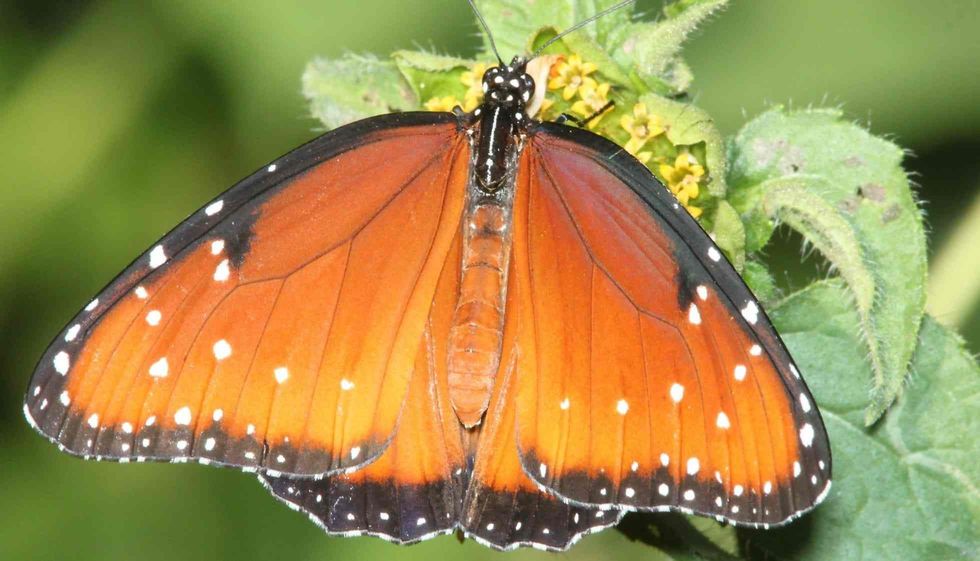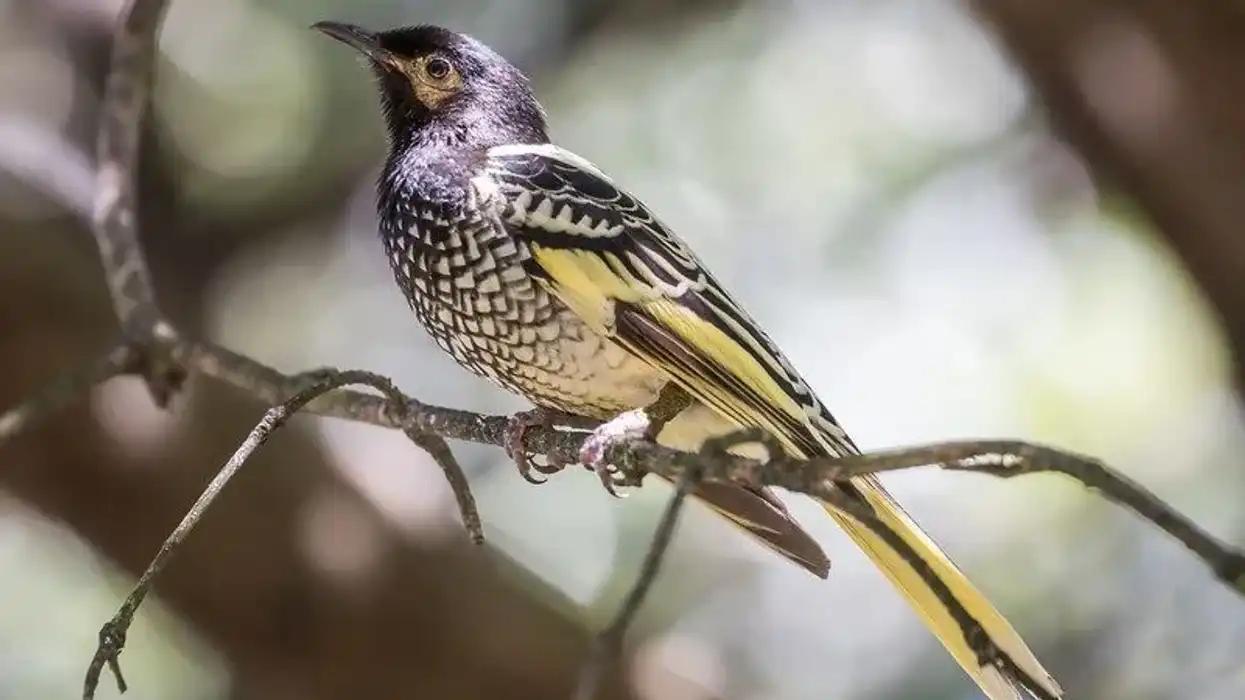The Queen is a beautiful species of butterfly. Its attractive orange-brown colored wings have black borders with white spots, and the hindwings have black veins. The beautiful butterfly loves warm and sunny areas, and the roost can be seen flying around almost all year round in open woodlands, fields, deserts, marshes, and forest edges.
This butterfly has many cousins like the Monarch and Soldier. These species have evolved together in a complex mimicry ring for their survival. The chemical defense that makes these butterflies unpalatable is derived from their host plants, milkweeds, and caterpillar feeds.
As a butterfly, the Queen loves to drink a lot of nectar, and it is said to nectar indiscriminately compared to its cousins. The Queen is beautiful all through its life cycle.
The eggs are beautiful pale green or white, while the caterpillar evolves out of them in beautiful white, yellow, and black patterns. The chrysalis is a beautiful jade with golden spots on it. The butterfly is a beauty in itself, symbolizing spiritual transformation and positive foretelling.
If you like this article then go through viceroy butterfly and red admiral butterfly facts too.
Queen Butterfly Interesting Facts
What type of animal is a queen butterfly?
The Queen butterfly, as the name suggests, is a butterfly. But unlike ants, termites, or honey bees, she doesn’t play the role of a queen. It is closely related to the Monarch butterfly and is similar in looks but is not the same.
What class of animal does a queen butterfly belong to?
The Queen butterfly, Danaus gilippus, belongs to the Insecta class in the Nymphalidae family and subfamily Danainae. The Queen belongs to the genus Danaus, including Danaus plexippus, Monarch butterfly, and Danaus eresimus, Soldier butterfly. There are seven subspecies.
How many queen butterflies are there in the world?
Queen butterflies are found in abundance in their habitat. Their exact count is unknown, but they can be seen at large during spring and summer.
Where does a queen butterfly live?
Queen butterflies are found in the fields, meadows, and at the edges of the forests in both tropics and temperate regions across Asia, Africa, Central America, and North America. It can be found in southern regions of the U.S., Georgia, Texas, New Mexico, and California. It can also be seen in peninsular Florida, Arizona, and Cuba.
What is a queen butterfly’s habitat?
The Queen butterfly’s host plant is milkweed, an important one in the Queen butterfly habitat. And it nectars a lot, sometimes indiscriminately.
They are attracted to the Lantanas, Pentas, and Purple Mistflower. These butterflies love a warm climate and can be seen in open sunny areas, including pastures, dunes, washes and waterways, and sometimes deserts and roadsides. They are migratory, but the queen butterfly range is lesser than any other butterfly species.
Who do queen butterflies live with?
They live in groups and roost communally. But you can spot them alone or in pairs occasionally.
They share their habitat with other insects like wasps and flies. To attract the Queen butterflies to their host plants, milkweeds planted in the surroundings will do the task. They love nectar, and adding flowering plants will make the surroundings beautiful with a roost of these wonderful butterflies.
How long does a queen butterfly live?
An adult Queen butterfly has a lifespan of about 20-35 days. A Queen butterfly caterpillar or a larva emerges from a pale green or white egg around a week.
The caterpillar stage lasts for about 9-15 days, during which they feed on the leaves of the milkweed plants.
After that, they turn into chrysalis or pupae stage and stay that way for about 8-14 days before the queen butterfly emerges. After two to three hours, when the wings are dry, the butterfly flies for around a month before dying, thus finishing all the queen butterfly stages.
How do they reproduce?
Queens reproduce by sexual reproduction. Males patrol to find their partners and seduce the female with a secretion called pheromones from their hair pencil during the courtship, called hair penciling.
The butterflies (the male and the female) remain coupled for more than an hour and rest up high on tree foliage. The female queen butterfly eggs are deposited closer to the ground than usual on mostly milkweed host plants. And the queen butterfly's life cycle starts.
What is their conservation status?
The conservation status of the Queens (Danaus gilippus) is Least Concern. They are widely found all year round in their habitat.
Queen Butterfly Fun Facts
What do queen butterflies look like?
The Queens are beautiful butterflies with attractive wings. The coloration of the wings is bright orange with black veins and black borders. The row of white spots is attractive over the bright hindwings.
How cute are they?
The Queens are eye-catching at first sight. Butterfly observers are never left unamused by these lovely creations. The wings are attractive. The beautiful antennae appear to be studying the world around them. The Queen caterpillar has black, yellow, and white color patterns similar to the Monarch caterpillar. In total, they are aesthetically beautiful.
How do they communicate?
Queen butterflies communicate with each other by scent and colors. They have chemical scent glands in the hind wings, and the male butterflies attract females with this scent. Some physical actions and unique gestures are said to be a way of communication though not much is yet known about this.
How big is a queen butterfly?
The Queen is one of the relatively large species of butterflies. The Queen butterfly has a wingspan of 2.8–3.5 in (7.1-8.9 cm). The body is two inches in length. Butterflies are ectotherms (cold-blooded) and rely on the sunlight to warm up. With broad wings stretched open, they bask in the sun to soak up the heat.
How fast can a queen butterfly fly?
Butterflies have evolved to take up long flights at high speeds, especially while migrating. A Queen butterfly can fly at a speed of 30 mph.
How much does a queen butterfly weigh?
Queen butterflies are lightweight and weigh only 0.1 oz (2.8 g). The caterpillars are lighter than the butterfly itself.
What are the male and female names of the species?
Both the genders of the Queens go with the same name. A cluster of Queen butterflies is called a roost. The butterflies don’t really sleep but rest or roost together. Roosting together keeps them warm during the night and camouflages them from predators.
What would you call a baby queen butterfly?
The Queen caterpillar that comes out of an egg has an outer covering called the cuticle. It is also known as the queen butterfly larva.
After that, the Queen butterfly chrysalis is formed with fantastic jade coloring and golden dots. Once the butterfly is out with its colorful wings, it is just a matter of minutes to hours before the wings dry, and the beauty is ready to take flight.
What do they eat?
The favorite of these butterflies is milkweed plants. They relish different types of milkweed. The butterflies enjoy nectar and love the nectar of Blue Mist, Fogfruit, and Shepherd’s needle flowers. They are also seen sipping water from the puddles or soil after rain to hydrate themselves and pick up salts from the soil. The process is called puddling.
Are they dangerous?
These little creatures are so delicate, so definitely, the word dangerous does not fit anywhere in its description. Queens protect themselves from dangers through the process called crypsis by camouflaging or blending in their surroundings.
Would they make a good pet?
Yes, raising a butterfly is a hobby a few take up. You can start by bringing in an egg or a caterpillar if you can find one.
By providing the feast of its host plant, you can raise the butterfly from its caterpillar stage, which may last about a week or more in the house.
But once the butterfly emerges from its chrysalis in about 8-10 days, it is better to release them into the open for it to survive. A butterfly house, also known as a lepidopterarium, is a facility to breed and display butterflies.
Did you know...
Female Queens can mate up to 15 times, a significantly higher number than other members of Lepidoptera.
A forest queen butterfly found in southeastern Africa and a tiger mimic queen butterfly found from Peru to the Caribbean is not the same as the queen butterfly. Their names sound similar, and both belong to the Nymphalidae family.
Soldier vs Queen butterfly: The Soldier is also known as the Tropic Queen butterfly (Danaus erasmus) and Queen butterfly (Danaus gilippus). Both belong to the Danaus genus, including the Monarch butterfly (Danaus plexippus).
How can you tell the gender of a queen butterfly?
The male and female Queens can be distinguished by observing them closely. Without the knowledge of these differences, a butterfly observer cannot differentiate the gender.
The presence of two distinguished white-colored dots on the hindwings of the male cannot be seen in a female. The black veins across the wings are thinner in males than in female butterflies. The male butterfly has a black scent patch on its hindwings.
What is the similarity between monarch and queen butterflies?
No wonder you cannot differentiate between Queens and Monarchs. If you list out Monarch vs Queen butterfly qualities and appearances, there will be more matches.
They have many similarities in appearance. Both the Monarch butterfly and the Queen butterfly love milkweeds as their host plants.
The coloration of orange-brown wings is similar too with black veins and black borders and white spots. The Monarch caterpillars have two set filaments with even patterns in white, yellow, and black, while the Queen caterpillars have three sets of filaments with patterns not so even when closely observed. The filaments are antennae-like protuberances.
Only one set at the caterpillar’s head is the real antenna, while others are tentacles for Monarch and the Queen butterfly. Monarch caterpillars have two sets of antennae on either side to throw off the predators, and the same is the case with the Queens with three sets.
Here at Kidadl, we have carefully created lots of interesting family-friendly animal facts for everyone to discover! Learn more about some other arthropods including the purple emperor butterfly or morpho butterfly.
You can even occupy yourself at home by drawing one on our Queen butterfly coloring pages.










